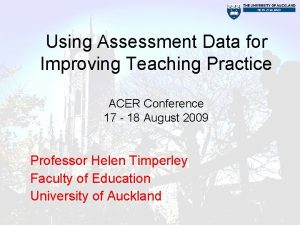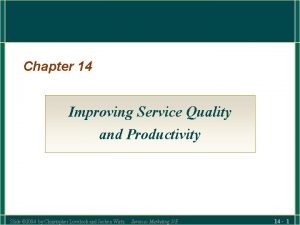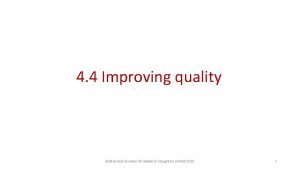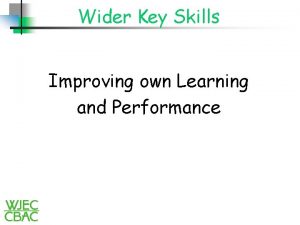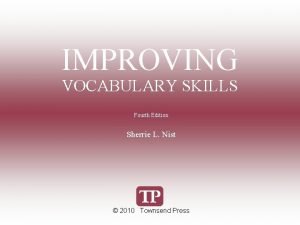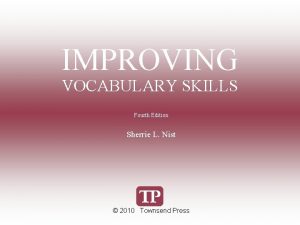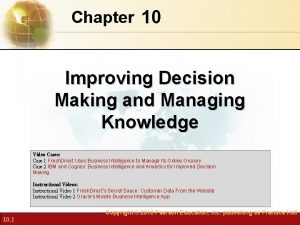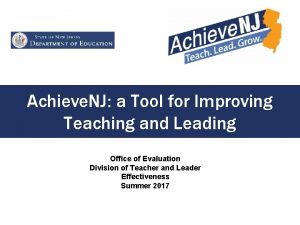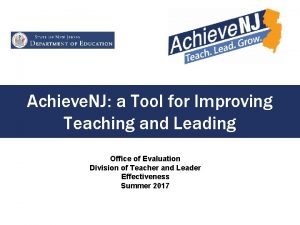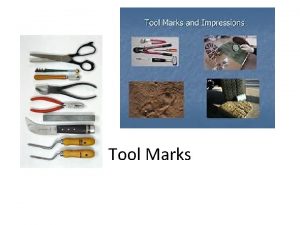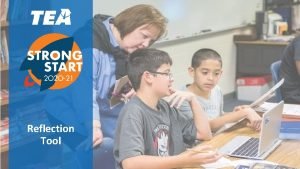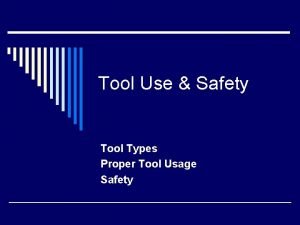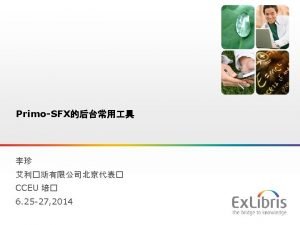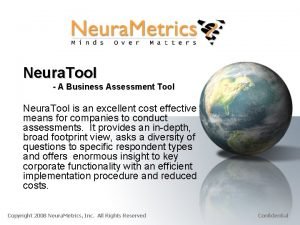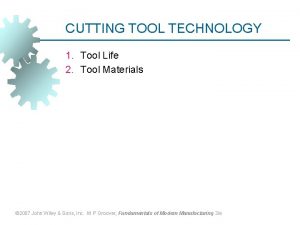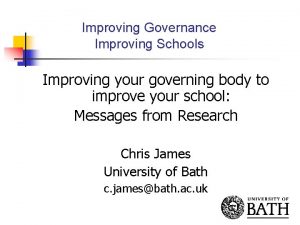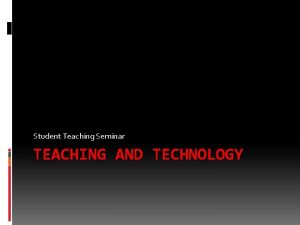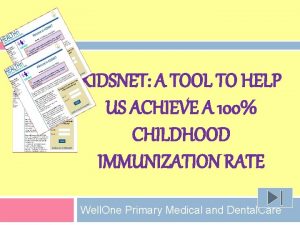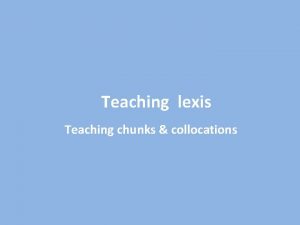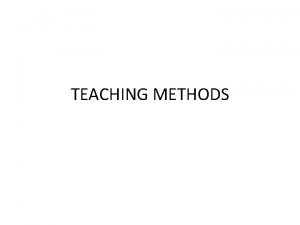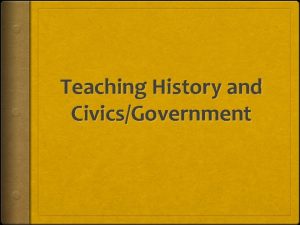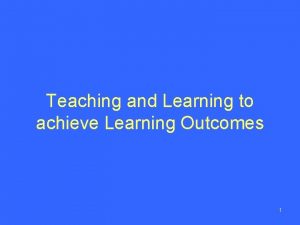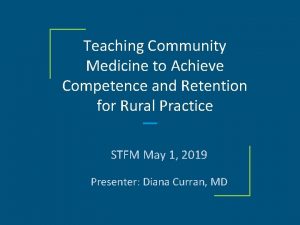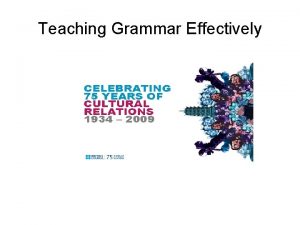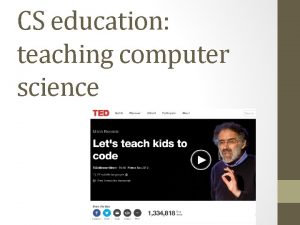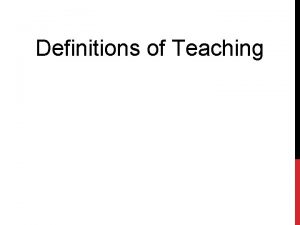Achieve NJ a Tool for Improving Teaching and
































![PDP Goal Setting Example Developing ]Slide 1 of. The 2 learning tasks and 3 PDP Goal Setting Example Developing ]Slide 1 of. The 2 learning tasks and 3](https://slidetodoc.com/presentation_image_h/0050d79d73f15715f5a4208334a9336d/image-33.jpg)













































- Slides: 78

Achieve. NJ: a Tool for Improving Teaching and Leading Office of Evaluation Division of Teacher and Leader Effectiveness Summer 2017

Agenda Using Accurate Evaluations to Inform Quality Professional Achieve. NJ: A Tool for Improving Teaching and Development Leading • Pete Mazzagatti Principal evaluation: Reframe and Align to Strengthen Leadership • Paul Palek Evaluating, Supporting and Retaining Highly Effective Teachers • Chelsea Collins 2

Improving Student Achievement Through Better Instruction 3

Achieve. NJ: A Tool for Improving Teaching and Leading (slide 1 of 3) 4

Achieve. NJ: A Tool for Improving Teaching and Leading (slide 2 of 3) 5

Achieve. NJ: A Tool for Improving Teaching and Leading (slide 3 of 3) 6

Hard Work is Paying Off: Teacher Evaluation Ratings are Improving • Since 2013, there are more Highly Effective teachers and fewer Partially Effective and Ineffective teachers • Our best teachers are still teaching (~95%) • Struggling teachers are improving (2/3) or leaving (1/3) • Thousands of teachers have improved over the past three years Ineffective Partially Effective Highly Effective Summative Rating 7

How Is Achieve. NJ Working? 1. Expectations for good teaching have been clarified 2. The observation process allows for improved conversations and feedback 3. Student and teacher data is being used to improve teacher practice 8

Growth Areas in Evaluation Area Objective Teacher Evaluation Use accurate evaluations to inform quality professional development Principal Evaluation Reframe observations and align components to strengthen school leadership Highly Effective Teachers Elevate, support and retain the best teachers to strengthen the educational community 9

Teacher Evaluation Using Accurate Evaluations to Inform Quality Professional Development Office of Evaluation Division of Teacher and Leader Effectiveness Summer 2017

Agenda (Using accurate Evaluations to inform quality In this session, we will discuss ways that professional teacher evaluation can development( be used to continue Quality Professional Development Accurate Evaluation to strengthen teaching • Improving accuracy of evaluation scores Improved Teaching • Aligning evaluation results to meaningful professional development plans • Leveraging Sc. IPs to provide strong professional development and support for staff particular novice teachers 11

The Value Of Accurate Data • Data and World Health 12

Observation Scores In Two Districts Which data set is more likely to tell a school district “where to go and how to act? ” Why? District 2 4 4 3. 5 Observation Scores District 1 3 2. 5 2 1. 5 1 3 Teachers 13

Teacher Evaluation: A Tool For Improving Teaching 14

Teacher Evaluation: A Tool For Improving Teaching 15

Improving Observation Score Accuracy 16

Quality Training Required – Annual updates and refresher training on practice instrument prior to observations – More thorough training for new evaluators – Two co-observations per year Best Practice + 1. Approach observation training as a cycle of continuous improvement 2. Use a variety of calibration activities 3. Establish protocols for evaluation components including pre- and post -conferences (guidance) 4. Use effective training to ensure that teachers fully understand how the practice instrument describes excellent teaching 17

Quality Training: Using Required Training Plus Best Practices To Drive Continuous Improvement Analyze evaluation data: plan training (slide 1 of 3) Train observers on practice instrument July/Aug May/June September Conduct video observation activity Engage in observation review activity Conduct video observation activity Conduct Observations Januar y November Participate in coobservations 18

Quality Training: Using Required Training Plus Best Practices To Drive Continuous Improvement (slide 2 of 3) Analyze evaluation data: plan training What action does this initial analysis suggest? 19

Quality Training: Using Required Training Plus Best Practices To Drive Continuous Improvement Analyze evaluation data: plan training (slide 3 of 3) Train observers on practice instrument July/Aug May/June September Conduct video observation activity Engage in observation review activity Conduct video observation activity Conduct Observations Januar y November Participate in coobservations 20

Quality Training: Using A Variety Of Calibration Activities Activity Step 1 Step 2 Step 3 Step 4 Video Observation Select a classroom video Collaboratively view the video and individually collect high quality evidence Assign the evidence to standards and provide scores Debate and discuss scores until consensus is reached Observation Report A school leader Review presents a classroom observation at a leadership team meeting Individually read and score the observation report using the observation quality rubric Resolve all questions Debate and discuss component level ratings and rationale Co-observation Collectively observe and individually record evidence Independently sort the evidence and score each component Reconvene to share and discuss component-level ratings and rationale Establish a procedure for pairing or grouping school administrators • Complete guidance including scoring debrief norms • Observation Quality Rubric 21

Deliberate Scoring (slide 1 of 2) Scoring Requirements – Teacher practice score (slide 1 of 2) determined through a state-approved practice instrument – Practice score must be between 1 and 4 District Discretion + List the aspects of scoring that you have discretion to decide. 22

Deliberate Scoring Slide (2 of 2) Scoring Requirements – Teacher practice score (slide 2 of 2) determined through a state-approved practice instrument – Practice score must be between 1 and 4 District Discretion + 1. Relative weights of practice domains 2. Use of decimal places to determine observation score 3. Prioritization of rubric standards 23

Deliberate Scoring: Weighting Domains* • Scoring weight decisions can have a significant impact on final scores • Choose weights that best reflect the priorities of your school/district III Instruction IV Professional Responsibilitie s Practice Score 30% 10% 100% 2. 7 2. 6 2. 5 3. 0 2. 6 Weight 2 25% 25% 100% Score 2 2. 7 2. 6 2. 5 3. 0 2. 7 I Planning and Preparation II Classroom Environment Weight 1 30% Score 1 * “Domains” refers to large groups of measures associated with teaching practice. Practice instruments use a variety of terms to describe these groups. Example of domains taken from Danielson. Weights used for illustrative purposes. only. Compare the scores at each weight? What do you notice? * “Domain” refers to a large group of practices associated with teaching. Practice instruments use a variety of terms to describe these groups. Example of domains taken from Danielson. Weights used for illustrative purposes only. 24

Deliberate Scoring: Using Decimal Places To Determine Domain Scores Component • Using decimal places (D. P. s), i. e. not rounding, provides more information within an evaluation Rating in Domain 2/Classroom Environment Ineffective Partially Effective 2 A Proficient Distinguishe d Domain Score Calculation Rounded One D. P. 3+2+2+3+3 5 3 2. 6 3 2 B 2 2 C 2 2 D 3 2 E 3 How would providing a score with one decimal place practically add value to the observation process? Example of practice language taken from Danielson. Scores used for illustrative purposes only. 25

Deliberate Scoring: Using Decimal Places To Determine Domain Scores • Using decimal places may reveal more specific areas of growth (slide 2 of 2) • More deliberate scoring shows certain teachers could benefit from specific PD or more intensive supervision, generally, e. g. Corrective Action Plan Scoring Method Teacher A Teacher B Planning (30%) Environment Instruction (30%) Professionalis m (10%) Practice Score Rounde d 3 3 3 1 D. P. 2. 7 2. 6 2. 5 3. 0 2. 6 Rounde d 3 3 3 1 D. P. 3. 1 3. 3 3. 4 3. 2 3. 3 What would be your recommendation for the teachers shown above based on their alternative scores? 26

Deliberate Scoring: Prioritizing Components* By Evaluating These Each Observation (Example Shown Is For Illustrative Purposes Only And Is Not A DOE Recommendation) Every Observation 1 Observation 2 Observation 3 Respect and Rapport Culture for Learning Communicating with Students Engaging Students in Learning Responsiveness and At Least Flexibility Responsiveness and Flexibility Once Classroom Procedures Managing Student Behavior Organizing Physical Space Using Questioning and Discussion Techniques Using Assessment in Instruction What particular aspects of teaching do you look for in every observation? * “Components” refers to specific areas of practice specified in observation instruments. Components are aligned to INTASC standards and cross cut all approved instruments. 27

Observation Scores In Two Districts What is one suggestion you have for District 1 for how to use deliberate scoring in improving accuracy? (continued) District 2 4 4 3. 5 Observation Scores District 1 3 2. 5 2 1. 5 1 3 Teachers 1 Teachers 28

Improving Observation Score Accuracy (continued) What is one concrete action step you are planning to take or might suggest your district take to increase scoring accuracy? 29

Evaluations Inform Professional Development • Evaluation data should be used individually and at a school level for professional development purposes Individual Teacher Data Teachers and Evaluators Teacher Professional Development Plan Aggregate School Data School Improvement Panel (Sc. IP) School Professional Development Plan Accurate Evaluations 30

Individual Professional Development Must Be Informed By Performance Evaluations Stated goal of the TEACHNJ Act “Raise student achievement by improving instruction through the adoption of evaluations that provide specific feedback to educators, inform the provision of aligned professional development, and inform personnel decisions. ” ~C. 18 A: 6 -118 *Pending adoption by State Board in Fall 2017 Revised QSAC Indicators* 2 a. An audit of personnel files indicates that required individual professional development plans (PDPs) or corrective action plans (CAPS) are aligned to the professional standards for school leaders or teachers and have been completed for administrators and teachers and are linked to (1) school district, school, team, and/or individual goals, and (2) results from individual performance evaluations. (N. J. A. C. 6 A: 9 C and 6 A: 10 -2. 5); 31

Professional Learning Aligned With The Evaluation Cycle Summer PD Summary Conference Review PDP progress, plan revisions Attend workshops, review literature First Month of School September Collect student data, determine instructional priorities April Finalize PDP Goals October 31 Pre-observation Conference Determine look-fors related to PDP February Peer Observation Collaborate with others to get and give feedback December Discuss in conjunction with SGOs Videotape Classroom Self-reflect on progress Post–observation Conference Discuss progress on goal 32
![PDP Goal Setting Example Developing Slide 1 of The 2 learning tasks and 3 PDP Goal Setting Example Developing ]Slide 1 of. The 2 learning tasks and 3](https://slidetodoc.com/presentation_image_h/0050d79d73f15715f5a4208334a9336d/image-33.jpg)
PDP Goal Setting Example Developing ]Slide 1 of. The 2 learning tasks and 3 c: Engaging Students in Learning Proficient The learning tasks and activities are partially aligned activities are fully aligned with the instructional outcomes and outcomes but require only are designed to challenge minimal thinking by students student thinking, inviting and little opportunity for them to students to make their thinking explain their thinking, allowing visible. This technique results in most students to be passive active intellectual engagement by or merely compliant. most students with important and challenging content, and with teacher scaffolding to support that engagement. 33

PDP Goal Setting Example Proficient Slide 2 of 2 The learning tasks and activities are fully aligned with the instructional outcomes and are designed to challenge student thinking, inviting students to make their thinking visible. This technique results in active intellectual engagement by most students with important and challenging content, and with teacher scaffolding to support that engagement. 1. Area Identified for Development: • Student Engagement in the Classroom. 2. Professional Learning Goals: • To improve the alignment of learning tasks and activities with the instructional outcomes. • Utilize greater alignment to challenge student thinking throughout lessons. 34

PDP Goal Setting Example 35

Leveraging The Sc. IP For Professional Development Sc. IP Requirements* • All schools convene a School Improvement Panel (Sc. IP) to – Identify professional development opportunities based on aggregate data including evaluation and student performance data – Oversee mentoring processes Examine Align Utilize aggregate Revisit data from multiple Align the work of the sources to inform the Sc. IP with the School Revisit the plan work. Professional multiple times during Development Plan. the year to revise based on available data. *Complete Sc. IP requirements and more information can be found at http: //www. state. nj. us/education/Achieve. NJ/scip/ 36

Using Observation Data To Improve Professional Development For Teachers Middle School A Comparison of Highest and Lowest Component Scores Highest Observation Instrument Components Professional Responsibilities (Domain Mean) 3. 30 Demonstrating Flexibility and Responsiveness 2. 87 Organizing Physical Space 2. 85 Managing Classroom Procedures 2. 81 Lowest Observation Instrument Components Questioning and Discussion Techniques 2. 48 Knowledge of Students 2. 47 Engaging Students in Learning 2. 44 Knowledge of Resources 2. 43 What does this data set tell you? Suggest one next step. 37

Using Survey Data To Strengthen Mentoring Programs High School B Mentorship Survey Results Mentees were asked to rate the following components on a scale of 1 -5 with 5 being the best rating. These are the cohort averages. Quality of mentor 3 Frequent support 2 The program was organized 3 The program was relevant 3 The program supported pedagogical needs The program assisted in understanding building and district protocols Communicatio n of program was clear 3 5 3 What does this data set tell you? Suggest one next step. 38

Thank You! From Pete Mazzagatti Next Steps: Identify one area for strengthening evaluation accuracy and/or alignment to professional development • Evaluation training • Evaluation scoring • PDPs • Sc. IP • Contact Information: – Pete Mazzagatti, Policy Manager – peter. mazzagatti@doe. state. nj. us – Office of Evaluation Quality Professional Development Accurate Evaluation Improved Teaching • Website and Resources Achieve. NJ Calibration activities Observation Quality Rubric Sc. IPs Achieve. NJ and Professional Development – educatorevaluation@doe. state. nj. us – (609) 376 -3974 39

Principal Evaluation Reframe and Align to Strengthen Leadership Office of Evaluation Division of Teacher and Leader Effectiveness Summer 2017

Agenda In this session, we will discuss ways that principal evaluation can be enhanced to strengthen leadership Reflect (principal evaluation) • Preparing for the evaluation cycle with a planning conference to reflect on priorities and goals • Aligning Administrator Goals and sustaining focus over two or three years • Redefining “observation” as a collection of evidence over an extended period of time Redefine Refine 41

Principal Evaluation: A Tool For Improving Leadership Principal leadership not only matters, it is second only to teaching among school-related factors in its impact on student learning, and the impact of leadership tends to be greatest in schools where the learning needs of the students are most acute. Providing meaningful feedback through principal assessment, and helping principals to adequately interpret feedback through coaching, are viable tools to improve leadership practice. * *P. Goff; E. Goldring; J. Guthrie; L. Bickman. “Changing principals’ leadership through feedback and coaching, 2014. Journal of Educational Administration, 52(5), 682 -704. 42

Principal Evaluation: A Tool For Improving Leadership (slide 1 of 2) 43

Principal Evaluation: A Tool For Improving Leadership (slide 2 of 2) 44

School Leader Evaluation In Two New Jersey Districts 2015 -16 Districts 1 and 2 are large urban districts with similar student growth scores District 2 100% 90% 80% 70% 60% 50% 40% 30% 20% 10% 0% Percent of Leaders District 1 Ineffective Partially Effective Summative Rating Highly Effective 100% 90% 80% 70% 60% 50% 40% 30% 20% 10% 0% Ineffective Partially Effective Highly Effective Summative Rating What might be some of the reasons for the difference in these charts? 45

2015 -16 School Leader Practice Scores Vs Teacher Practice Scores 50% Percent of Educators 45% 40% 35% 30% 25% 20% 15% 10% 5% 0% 2. 25 -2. 49 2. 5 -2. 74 3 -3. 24 3. 25 -3. 49 3. 5 -3. 74 3. 75 -4 Practice Scores Teacher Principal • What is the difference between teacher and principal practice ratings? • What might explain this difference? 46

Principal Evaluation Challenges – 8% school leaders did not receive a summative score in 2015 -16 – Only 38 principals/APs/VPs were identified as needing extra support in 2015 -16 • School leader evaluation has taken a backseat to other priorities, including teacher evaluation • District leader turnover is high (~100 annually) making evaluation quality and consistency for principals challenging to maintain • The work of the principal is inherently different from that of the teacher but observation processes may not reflect this • Administrator goals do not necessarily align with district priorities or reflect how a principal creates change in a school 47

3 Rs to Strengthen Leadership Through Evaluation A planning conference initiates the evaluation cycle Reflect Observations become a collection of evidence over time Redefin e Refine Administrator goal focus extends over multiple years and aligns to school/district priorities 48

Looking For The Right Things Using The Standards Revised Professional Standards for Educational Leaders* emphasize the following: • Student learning • Human relationships Leadership Practices Teaching and Learning School Community • Instructional leadership • Distributed leadership Student Achievement Other Student Outcomes Other School Outcomes Ex. PARCC, AP/IB, Benchmarks Ex. Chronic absenteeism, course enrollment, grad rates Ex. Climate and culture, higher ed partnerships, family engagement *Professional Standards for Educational Leaders (PSEL) were adopted by New Jersey in March 2017 Analysis of ISLLC and PSEL - http: //www. nasbe. org/wp-content/uploads/Prociw_Leader-Stds-Final. pdf 49

Stages Of The Evaluation Cycle SGO average and m. SGPs (for those who qualify) are also included in the final evaluation score of school leaders. The Evaluation Leadership Instrument, now optional, may also be used for evaluation. 50

Evaluation Cycle Timeline And Activities http: //www. state. nj. us/education/Achieve. NJ/resources/Using. Principal. Ev aluationto. Improve. School. Leader. Effectiveness. pdf 51

Reflect Begin With An Annual Planning Conference • Why – Builds a collaborative foundation – Develops a shared understanding of district/school/professional goals – Clarifies evaluation process expectations • What 1. Discuss student and school data and develop areas of focus 2. Align priorities for Admin Goals and PDP 3. Identify priority standards on practice rubric aligned to goals 4. Determine potential sources of 52

Refine Rowing Together In The Right Direction *A Harris Poll of 23, 000 U. S. residents employed full time within key industries and in key functional areas shows: • 37 percent have a clear understanding of what their organization is trying to achieve and why. • 1 in 5 was enthusiastic about their team’s and organization’s goals. • Only 15 percent felt that their organization fully enables them to execute key goals. • Only 15 percent felt they worked in a high-trust environment. If this were a basketball team: • Only 2 or 3 players would know which basket was their own… …and only 1 would care • Only one or two would know what position they play in and know exactly what they are supposed to do • Four players would, in some way, be competing against their own team rather than the opponent. *Adapted from “The 8 th Habit: From Effectiveness to Greatness” by Steven 53

Refine Administrator And Other Goals • As shown by the previous example, having clear, and aligned goals is important for success in complex organizations. • However, school districts often suffer from having too many goals, many of which may not be aligned or communicated throughout the organization Administrator District Goals PDP District Improvement School Board Superintendent Merit School Improvement SGOs 54

Refine Align Administrator Goals 55

Refine Align Administrator Goals 56

Refine • • Align Administrator Goals District experiencing rapidly changing demographics ELL students at Mountainside Middle School (MMS) show below average growth in math. Year 1 Goal MMS will show considerable improvement in the delivery of math instruction to ELL students by the end of school year 2017 -18, as measured by an increase in the average of teacher satisfaction on the end-of-year survey to 3. 8 /5. – Baseline score: 2. 3/5 – Action steps: PD for teachers, improved scheduling, updated curriculum Year 2 Goal 43 percent of ELL students at MMS will meet or exceed their target scores on the EOY math assessment with targets to be set by the district benchmark testing for SY 2017 -18. – Baseline score: 35% of ELL students met targets (an average of the past two years, up 4% from the prior year). – Action steps Improved process in data tracking and intervention. 57

Observations: A Collection of Evidence Over Time Observation 2 From discrete observations Observation 1 Redefine. O To collecting a portfolio of evidence Planning Conference Observation Window 1 Observatio n Conference Annual Conference Observation Window 2 Additional window for nontenured Turn and Talk: What evidence would lead to actionable feedback? 58

Redefine Observations: A Collection of Evidence Over Time • Four types of evidence • Direct Observation: the principal is present and leading – e. g. a post-observation conference, instructional rounds, hiring interview, a faculty meeting • Indirect Observation: the principal is not present and his or her effect is being seen indirectly – e. g. a data meeting led by a teacher leader, or stakeholder feedback on a survey, testimony of staff and students • Artifacts: a record of the principal’s work – e. g. blog, tweet, agenda, Power. Point from principal-led PD, parent letters • Student Data – e. g. PARCC and benchmark testing results 59

Thank You! From Paul Palek Next Steps: Identify one area of principal evaluation that your district might choose to prioritize Reflect – Reflect through a Planning Conference Redefine Refine – Refine Administrator Goals • – Redefine Observations Contact Information: • Website and Resources – Paul Palek Achieve. NJ – Implementation Manager Principal Evaluation Guidance – paul. palek@doe. state. nj. us Administrator Goals – Office of Evaluation – educatorevaluation@doe. state. nj. us – (609) 376 -3974 60

Elevating, Supporting and Retaining Highly Effective Teachers Office of Evaluation Division of Teacher and Leader Effectiveness Summer 2017

Agenda In this session, we will discuss ways to elevate, support, and retain Highly Effective teachers 1. Why it’s critical, and 2. How we can do it more intentionally ate Elev Support Reta in Highly Effective Teachers 62

Research Says: Teachers Matter Most • Teachers matter more to student achievement than any other aspect of schooling. – Teachers have two to three times the impact of any other school factor, including services, facilities, and even leadership. * RAND Corporation (2012). Teachers matter: Understanding teachers' impact on student achievement. Santa Monica, CA: http: //www. rand. org/pubs/corporate_pubs/CP 693 z 1 -2012 -09. html. 63

Teacher Evaluation: A Tool for Improving Our Best Teachers 64

Teacher Evaluation: A Tool for Improving Our Best Teachers 65

Are Our Best Getting Better? 66

Elevating Our Best • Achievement Coaches are one example of how districts are using the evaluation system to identify and leverage their best teachers. ate Elev Support Reta in Highly Effective Teachers 67

Better Outcomes For More Students Given the right conditions, these teachers can improve the practice of their colleagues… … which can lead to better outcomes for more kids. 68

Achievement Coach Districts & Impact Districts Bergenfield Boro Mantua Township Caldwell-West Caldwell Maurice River Township Clearview Regional Metuchen Delsea Regional Morris County Voc. Tech East Brunswick North Plainfield Borough East Greenwich Township Old Bridge Township Elizabeth Palisades Park Gloucester Township Passaic City Hopatcong Piscataway Township Jackson Township Princeton Jersey City Sayreville Lacey Township Scotch Plains-Fanwood Little Egg Harbor South River “The Achievement Coaches working with me helped facilitate my learning in an effective way. ” http: //www. state. nj. us/education/Achieve. NJ/achievementcoaches/ 69

Supporting Our Best ate Elev Support Reta in Highly Effective Teachers Great Teachers Seek to grow their practice Administrators Reflective Practice Protocol Help teachers grow by Crave effective feedback promoting self-reflection A viable option for in evaluation evaluating Highly Effective teachers to support their continued growth 70

Best Practices • ACTIVITY: With a partner, discuss how a great teacher has used one or more of the areas below to develop his/her practice or the practice of a colleague in order to deliver better, more responsive instruction to students. Which has had the most significant impact? – Student Feedback – Student Assessment – Classroom Video – Evaluation Observation 71

Reflective Practice Protocol Summative Rating Teacher Practice Reflective Conference Video Lesson Capture Reflection Student Achievement Traditional Classroom Observation(s) Student Voice Reflection SGO/m. SGP Traditional Classroom Observation Reflection http: //www. state. nj. us/education/Achieve. NJ/teacher/ Student Assessment Reflection 72

Autonomy & Flexibility for Districts and Teachers • Autonomy to define accomplishment and timing of the Reflective Conference. • Flexibility to emphasize areas that best support the teacher’s focus. • Additional options – Cooperating Teachers Video Reflection Student Voice Reflection Reflective Conference Assessme nt Reflection – Teachers Pursuing National Board Certification. Observatio n Reflection http: //www. nj. gov/education/Achieve. NJ/teacher/Reflective. Practice. Rationale. pdf 73

Retaining Our Best 74

Teacher Leader Endorsement *Program Providers – Institutes of Higher Education, Education Organizations, Non-Profit Entities, or a combination www. njea. org/teacher-leader-endorsements-moves-njdoe 75

Districts as Program Providers • Why – Build a cohort of teacher leaders to enhance culture and instructional practices – Invest in local talent and create a homegrown leadership pipeline – Retain the best teachers by offering new growth opportunities • How – Develop an endorsement program to suit the needs of the district and its teachers – Provide the program as professional development alternative to enrollees – Sustain program by offering program at a cost to other districts 76

Benefits Of The Teacher Leader Endorsement Teacher Concern Response I am already a teacher leader; I don’t need an endorsement Training can hone existing leadership skills, and build additional areas of expertise. I am too busy to enroll in an endorsement program When the program takes place locally, it reduces travel time and costs; it can replace other PD requirements I would rather pay money for a supervisor’s certificate. Unlike a supervisor’s certificate, the teacher leader endorsement earned through a district has minimal cost. 77

Thank You! Next Steps: Identify one strategy related to Highly Effective teachers that you are considering for your district From Chelsea Collins • Elevate: Achievement Coaches Model • Support: Reflective Practice Protocol Contact Information: Retain: Teacher Leader • – Chelsea Collins Endorsement – Policy Manager for Accomplished Teaching and Teacher Leadership – Chelsea. Collins@doe. state. nj. us – Office of Evaluation – educatorevaluation@doe. state. nj. us ate Elev Support Reta in Highly Effective Teachers • Website and Resources Achieve. NJ Achievement Coaches Reflective Practice Protocol Teacher Leader Report – (609) 376 -3974 78
 Using assessment data for improving teaching practice
Using assessment data for improving teaching practice Difference between micro teaching and traditional teaching
Difference between micro teaching and traditional teaching Teaching styles self-assessment tool
Teaching styles self-assessment tool Improving service quality and productivity ppt
Improving service quality and productivity ppt Benefits and difficulties of improving quality
Benefits and difficulties of improving quality Improving own learning and performance examples
Improving own learning and performance examples Aliens meaning
Aliens meaning Improving vocabulary with word parts and context clues
Improving vocabulary with word parts and context clues Improving decision making and managing knowledge
Improving decision making and managing knowledge Potter's tool is data cleaning tool
Potter's tool is data cleaning tool Fspos vägledning för kontinuitetshantering
Fspos vägledning för kontinuitetshantering Typiska novell drag
Typiska novell drag Tack för att ni lyssnade bild
Tack för att ni lyssnade bild Vad står k.r.å.k.a.n för
Vad står k.r.å.k.a.n för Varför kallas perioden 1918-1939 för mellankrigstiden
Varför kallas perioden 1918-1939 för mellankrigstiden En lathund för arbete med kontinuitetshantering
En lathund för arbete med kontinuitetshantering Personalliggare bygg undantag
Personalliggare bygg undantag Personlig tidbok fylla i
Personlig tidbok fylla i A gastrica
A gastrica Vad är densitet
Vad är densitet Datorkunskap för nybörjare
Datorkunskap för nybörjare Stig kerman
Stig kerman Att skriva debattartikel
Att skriva debattartikel Magnetsjukhus
Magnetsjukhus Nyckelkompetenser för livslångt lärande
Nyckelkompetenser för livslångt lärande Påbyggnader för flakfordon
Påbyggnader för flakfordon Lufttryck formel
Lufttryck formel Publik sektor
Publik sektor Jag har gått inunder stjärnor text
Jag har gått inunder stjärnor text Presentera för publik crossboss
Presentera för publik crossboss Jiddisch
Jiddisch Kanaans land
Kanaans land Klassificeringsstruktur för kommunala verksamheter
Klassificeringsstruktur för kommunala verksamheter Mjälthilus
Mjälthilus Bästa kameran för astrofoto
Bästa kameran för astrofoto Centrum för kunskap och säkerhet
Centrum för kunskap och säkerhet Programskede byggprocessen
Programskede byggprocessen Mat för unga idrottare
Mat för unga idrottare Verktyg för automatisering av utbetalningar
Verktyg för automatisering av utbetalningar Rutin för avvikelsehantering
Rutin för avvikelsehantering Smärtskolan kunskap för livet
Smärtskolan kunskap för livet Ministerstyre för och nackdelar
Ministerstyre för och nackdelar Tack för att ni har lyssnat
Tack för att ni har lyssnat Referatmarkeringar
Referatmarkeringar Redogör för vad psykologi är
Redogör för vad psykologi är Borstål, egenskaper
Borstål, egenskaper Tack för att ni har lyssnat
Tack för att ni har lyssnat Borra hål för knoppar
Borra hål för knoppar Orubbliga rättigheter
Orubbliga rättigheter Formel för standardavvikelse
Formel för standardavvikelse Tack för att ni har lyssnat
Tack för att ni har lyssnat Rita perspektiv
Rita perspektiv Vad är verksamhetsanalys
Vad är verksamhetsanalys Tobinskatten för och nackdelar
Tobinskatten för och nackdelar Toppslätskivling dos
Toppslätskivling dos Handledning reflektionsmodellen
Handledning reflektionsmodellen Egg för emanuel
Egg för emanuel Elektronik för barn
Elektronik för barn Plagg i rom
Plagg i rom Strategi för svensk viltförvaltning
Strategi för svensk viltförvaltning Kung som dog 1611
Kung som dog 1611 Indikation för kejsarsnitt på moderns önskan
Indikation för kejsarsnitt på moderns önskan Ro i rom pax
Ro i rom pax Tack för att ni lyssnade
Tack för att ni lyssnade Vilket tal pekar pilen på
Vilket tal pekar pilen på Vad är lyrik
Vad är lyrik Inköpsprocessen steg för steg
Inköpsprocessen steg för steg Rbk-mätning
Rbk-mätning Ledarskapsteorier
Ledarskapsteorier Kolposkopi, px
Kolposkopi, px Myndigheten för delaktighet
Myndigheten för delaktighet Frgar
Frgar Sju principer för tillitsbaserad styrning
Sju principer för tillitsbaserad styrning Läkarutlåtande för livränta
Läkarutlåtande för livränta Tät skog karttecken
Tät skog karttecken Geometri för barn
Geometri för barn Shaktismen
Shaktismen Vad är vanlig celldelning
Vad är vanlig celldelning Bris för vuxna
Bris för vuxna
